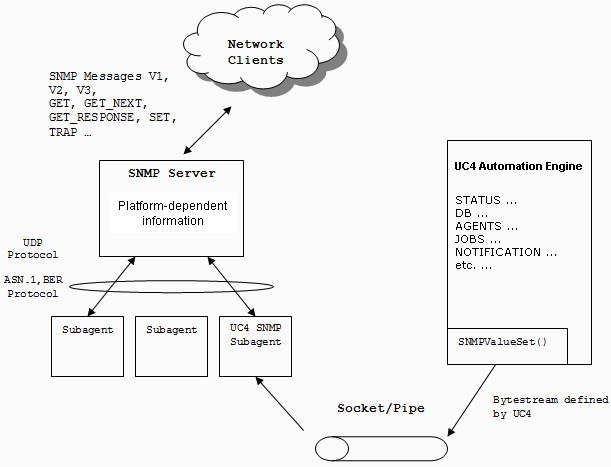
|
About SNMP |

SNMP Support |
Agent Mode on UNIX |

|
SNMP can be used to monitor the various conditions which occur within an AE system. Its activities include monitoring the availability of the Automation Engine and agents, active notifications or blocking tasks.
As of version 11.2 the new JMX-based monitoring solution, External Monitoring Interface (EMI) has been introduced. As the SNMP technology now is rather out-dated, Automic strongly recommends using the state of the art JMX solution.
SNMP uses the less secure UDP network protocol and since some time also is not able anymore to support the whole range of AE functions.
The following illustration explains the interaction of AE and SNMP:

With the SNMP connection being activated, the relevant AE system monitoring values are sent to the AE SNMP Subagent. It stores this information in its MIB and makes it available for the SNMP Masteragent. The MIB content is write protected, the AE SNMP Subagent prevents values from being modified with the SNMP command SET.
For applications (e.g. HP OpenView Operations), there are two methods to obtain information:
In particular situations, the Automation Engine generates predefined traps. You can also send traps using the script statement :SEND_SNMP_TRAP.
Specify in the AE SNMP Subagent's INI file whether the MIB should be loaded and/or traps be sent. By default, both is done. Automic recommends deactivating MIB loading if you intend to use traps only in order to avoid unnecessary performance loads.The corresponding parameter processing= is available in the section [SNMP].
The AE SNMP Subagent under UNIX is able to act as SNMP Masteragent with the advantage being that no SNMP service must be configured.
See also:
MIB Structure
Installing the AE SNMP Subagent (UNIX)
Installing the AE SNMP Subagent (Windows)
AE SNMP-Subagent's Glossary and FAQ